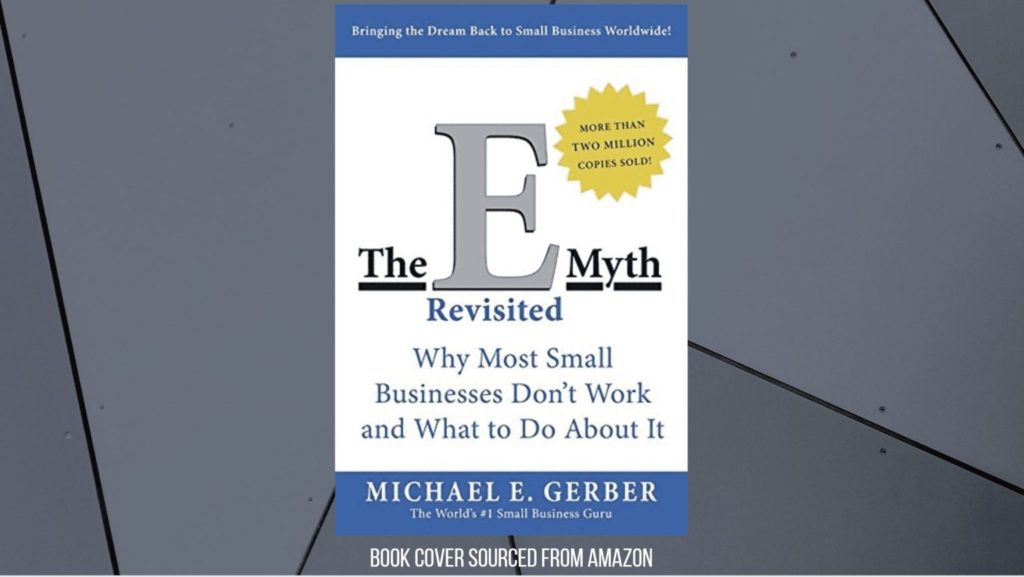This post may contain affiliate links, which means I’ll receive a commission if you purchase through my links, at no extra cost to you. Please read full disclosure for more information.
HIGH-LEVEL SUMMARY
The E-Myth Revisited is a book for those who own a small business or aspire to start their own small business. Author Michael Gerber has years of experience in running small businesses and consulting for others. Michael will show you how to produce results while dispelling the myths around starting your own business. He will walk you through the different phases, from infancy to maturity.
The book focuses on four profound ideas:
- There is a myth, called the e-myth, which says that small businesses are started by entrepreneurs risking capital to make a profit.
- A revolution, called the Turn-Key Revolution, is going on today in American small business.
- A dynamic process, called the Business Development Process, is at the heart of the Turn-Key Revolution.
- The Business Development Process can be systematically applied by all small business owners in a step-by-step method.
Link to book
The E-Myth Revisited can be found on Amazon at this link here if you are interested in reading.
Related reading
- Book Review: The Personal MBA by Josh Kaufman
- Book Review: Your Next Five Moves by Patrick Bet-David
- Soft Skills vs Hard Skills
- Fixed Mindset vs Growth Mindset
- 10 Best Tips on How to Stay Positive When Things Get Tough
TOP 35 TAKEAWAYS
In no particular order
1. Contrary to popular belief, people who are exceptionally good in business aren’t so because of what they know but because of their insatiable need to know more.
2. The great ones seem to possess an intuitive understanding that the only way to reach something higher is to focus their attention on the multitude of seemingly insignificant, unimportant, and boring things that make up every business. They have a genuine fascination for the truly astonishing impact little things done exactly right can have on the world.
3. Businesses start and fail in the United States at an increasingly staggering rate. Statistics tell us that by the end of the first year at least 40 percent of them will be out of business. Within five years, more than 80 percent of them will have failed.
4. The E-Myth is the myth of the entrepreneur. It runs deep in this country and rings of the heroic. The legend reeks of nobility, of lofty, extra-human efforts, of a prodigious commitment to larger-than-life ideals.
5. The Fatal Assumption: if you understand the technical work of a business, you understand a business that does that technical work. In fact, this is the root cause of most small business failures! The technical work of a business and a business that does that technical work are two totally different things.
6. The technician suffering from an Entrepreneurial Seizure takes the work he loves to do and turns it into a job. The work that was born out of love becomes a chore, among a welter of other less familiar and less pleasant chores.
7. The problem is that everybody who goes into business is actually three-people-in-one: The Entrepreneur, The Manager, and The Technician. The Entrepreneur is our creative personality—always at its best dealing with the unknown, prodding the future, creating probabilities out of possibilities, engineering chaos into harmony. Without The Manager there would be no planning, no order, no predictability. The Technician is the doer. The typical small business owner is only 10 percent Entrepreneur, 20 percent Manager, and 70 percent Technician.
8. Most businesses are operated according to what the owner wants as opposed to what the business needs.
9. Three phases of a business’s growth: Infancy, Adolescence, and Maturity.
10. The infancy stage is the Technician stage. In infancy, you (the business owner) are the business. Infancy ends when the owner realizes that the business cannot continue to run the way it has been; that, in order for it to survive, it will have to change.
11. Because as a Technician-turned-business-owner, your focus is upside down. You see the world from the bottom up rather than from the top down.
12. The Entrepreneurial Perspective asks the question: “How must the business work?” The Technician’s Perspective asks: “What work has to be done?”
13. The Entrepreneurial Perspective sees the business as a system for producing outside results—for the customer—resulting in profits. The Technician’s Perspective sees the business as a place in which people work to produce inside results—for The Technician—producing income.
14. The Entrepreneurial Perspective starts with a picture of a well-defined future, and then comes back to the present with the intention of changing it to match the vision. The Technician’s Perspective starts with the present, and then looks forward to an uncertain future with the hope of keeping it much like the present.
15. The Entrepreneurial Perspective envisions the business in its entirety, from which is derived its parts. The Technician’s Perspective envisions the business in parts, from which is constructed the whole.
16. When The Entrepreneur creates the model, he surveys the world and asks: “Where is the opportunity?” To The Entrepreneur, the business is the product. To The Technician, the product is what he delivers to the customer.
17. The true genius of Ray Kroc’s McDonald’s is the Business Format Franchise. He designed a systems-dependent business, not a people-dependent business. A business that could work without him.
18. Where 80 percent of all businesses fail in the first five years, 75 percent of all Business Format Franchises succeed! The reason for that success is the Franchise Prototype. To the franchisor, the Prototype becomes the working model of the dream; it is the dream in microcosm. The only criterion of value becomes the answer to the ultimate question: “Does it work?”
19. To The Entrepreneur, the Franchise Prototype is the medium through which his vision takes form in the real world. To The Manager, the Franchise Prototype provides the order, the predictability, the system so important to his life. To The Technician, the Prototype is a place in which he is free to do the things he loves to do—technical work.
20. You want to work on your business, not in it. The point is: your business is not your life.
21. Once you recognize that the purpose of your life is not to serve your business, but that the primary purpose of your business is to serve your life, you can then go to work on your business, rather than in it, with a full understanding of why it is absolutely necessary for you to do so.
22. Pretend that the business you own—or want to own—is the prototype, or will be the prototype, for 5,000 more just like it.
23. 1. The model will provide consistent value to your customers, employees, suppliers, and lenders, beyond what they expect. 2. The model will be operated by people with the lowest possible level of skill. 3. The model will stand out as a place of impeccable order. 4. All work in the model will be documented in Operations Manuals. 5. The model will provide a uniformly predictable service to the customer. 6. The model will utilize a uniform color, dress, and facilities code.
24. Your business model should not rely on highly skilled and specialized labor. If it does, it’s going to be impossible to replicate. Such people are at a premium in the marketplace. They’re also expensive.
25. Ask: How can I create a business whose results are systems-dependent rather than people-dependent? The system becomes the tools your people use to increase their productivity, to get the job done in the way for your business to successfully differentiate itself from your competition.
26. Create operating procedures and manuals for your business. Documentation provides your people with the structure they need and with a written account of how to “get the job done” in the most efficient and effective way.
27. Ask yourself the following questions: How can I get my business to work, but without me? How can I get my people to work, but without my constant interference? How can I systematize my business in such a way that it could be replicated 5,000 times, so the 5,000th unit would run as smoothly as the first? How can I own my business, and still be free of it? How can I spend my time doing the work I love to do rather than the work I have to do?
28. Innovation, Quantification, and Orchestration. Without Quantification, how would you know whether the Innovation worked?
29. Imagine how impressed the potential buyer of your business would be upon being presented with such order, such predictability, such irreproachable control.
30. The Business Development Program is composed of seven distinct steps: 1. Your Primary Aim 2. Your Strategic Objective 3. Your Organizational Strategy 4. Your Management Strategy 5. Your People Strategy 6. Your Marketing Strategy 7. Your Systems Strategy. The Business Development Process has the power to transform any small business into an incredibly effective organization.
31. Before you can determine what you role will be, you must ask yourself these questions: What do I value most? What kind of life do I want? What do I want my life to look like, to feel like? Who do I wish to be?
32. Your Strategic Objective is a very clear statement of what your business has to ultimately do for you to achieve your Primary Aim. In this context, your business is a means rather than an end, a vehicle to enrich your life rather than one that drains the life you have.
33. Unless your Business Strategy and Plan can be reduced to a set of simple and clearly stated standards, it will do more to confuse you than to help.
34. The System will become your management strategy, the means through which your Franchise Prototype produces the results you want. “What we do here is simple. Anyone can do it.” He opened the binder to the table of contents. “This is our Operations Manual. As you can see, it’s nothing but a series of checklists.”
35. There are three kinds of systems in your business: Hard Systems, Soft Systems, and Information Systems.
11 ACTIONS YOU SHOULD TAKE
1. As a business owner, care about every nook and cranny of the business. You need to focus attention on the multitude of seemingly insignificant, unimportant, and boring things that make up every business.
2. Differentiate the technical work of the business versus the business that does technical work.
3. Aim to find a balance between being the technician, manager, and entrepreneur.
4. Understand the three phases of a business’s growth: infancy, adolescence, and maturity. Understand what goes on in the business owner’s mind during each phase.
5. Get a clear picture on what you want your company to look like when it is finally done. Like IBM’s founder Tom Watson, ask yourself how a company which looked like that would have to act. The business has to act like a great company before it can become a great company.
6. Brainstorm ways to make your business systems-dependent, not people-dependent.
7. Aim not to have your life serve your business, but your business serve your life.
8. Ensure your business acts orderly, doing things in a predictable, uniform way.
9. Go to work on your business rather than in it. You should be able to replace yourself with a system.
10. For innovation, continually ask yourself: What is standing in the way of my customer getting what he wants from my business?
11. Quantify the areas of your business to understand where you currently are, where you have been, and where you need to be in the future.
QUESTIONS TO ASK YOURSELF TO DETERMINE YOU PRIMARY AIM
Your Primary Aim is where you wish your life to be. It’s the vision necessary to provide you with purpose and energy.
- What do I wish my life to look like?
- How do I wish my life to be on a day-to-day basis?
- What would I like to be able to say I truly know in my life, about my life?
- How would I like to be with other people in my life—my family, my friends, my business associates, my customers, my employees, my community?
- How would I like people to think about me?
- What would I like to be doing two years from now? Ten years from now? Twenty years from now? When my life comes to a close?
- What specifically would I like to learn during my life—spiritually, physically, financially, technically, intellectually? About relationships?
- How much money will I need to do the things I wish to do? By when will I need it?



